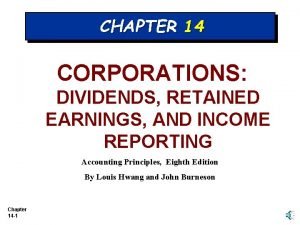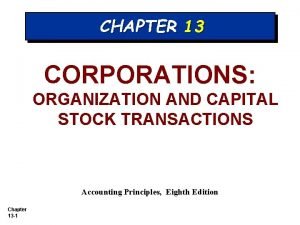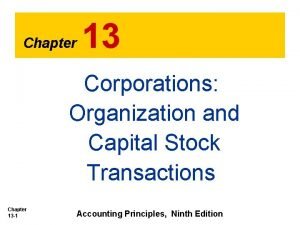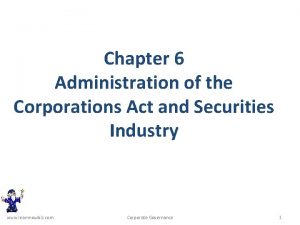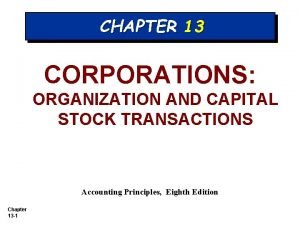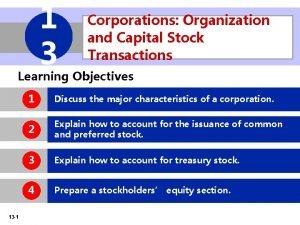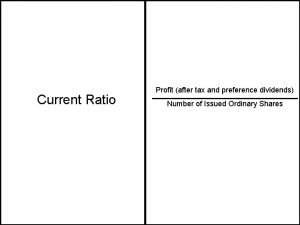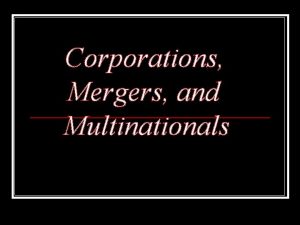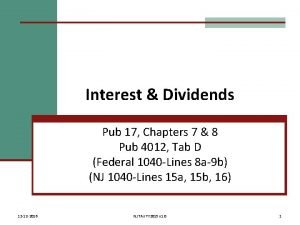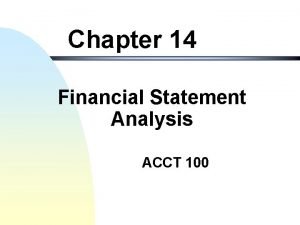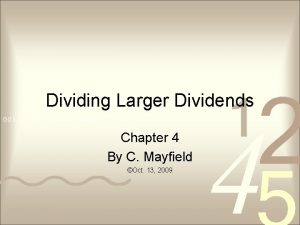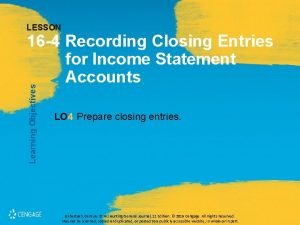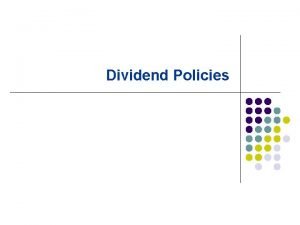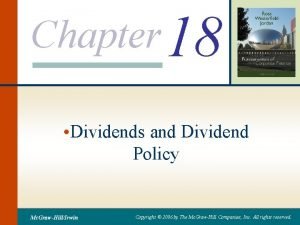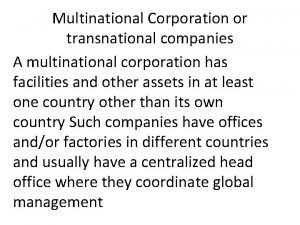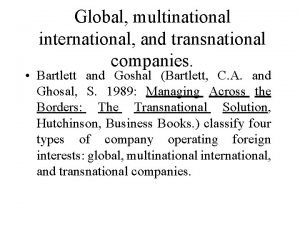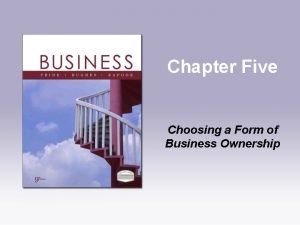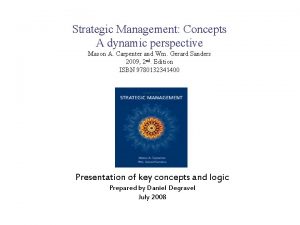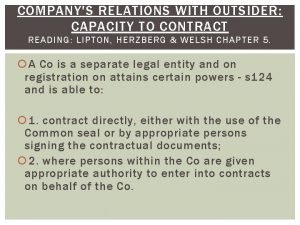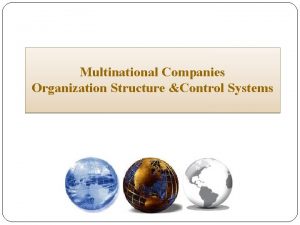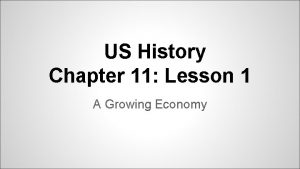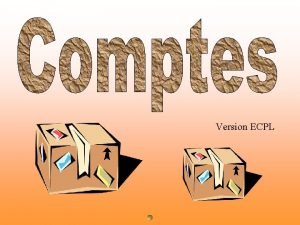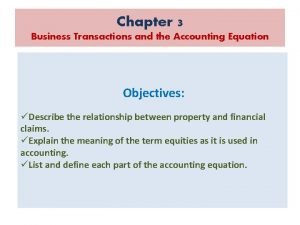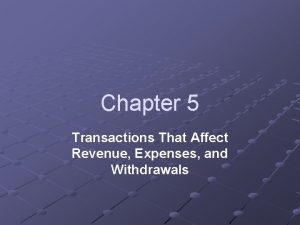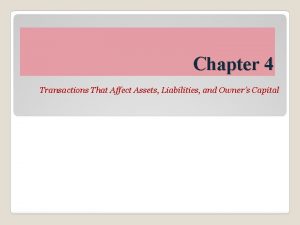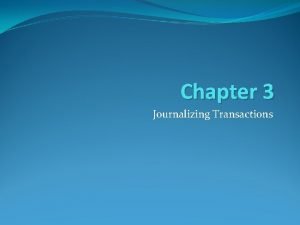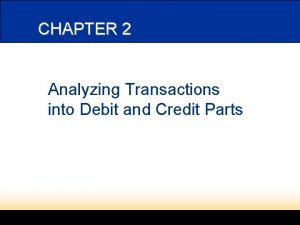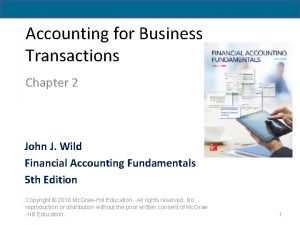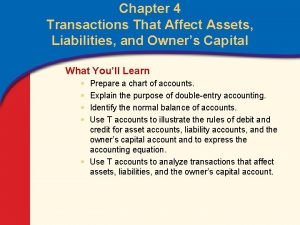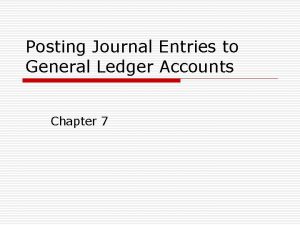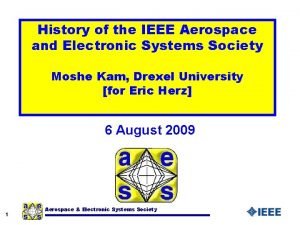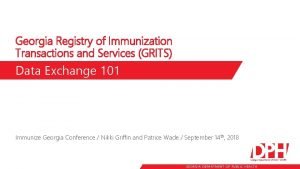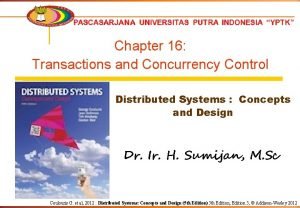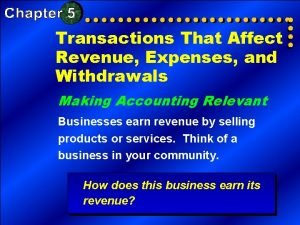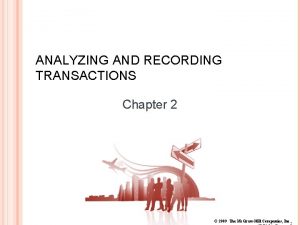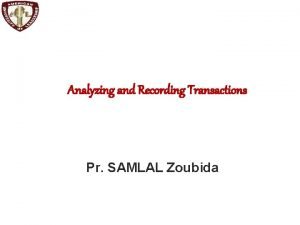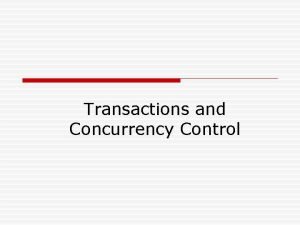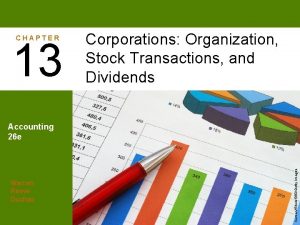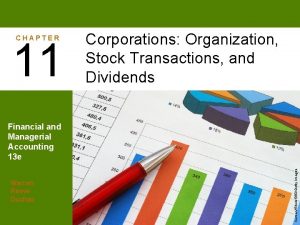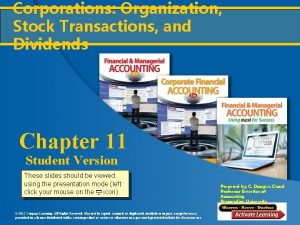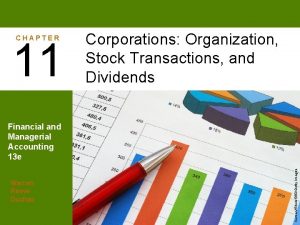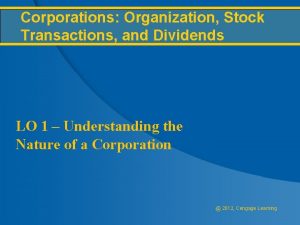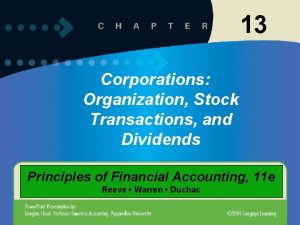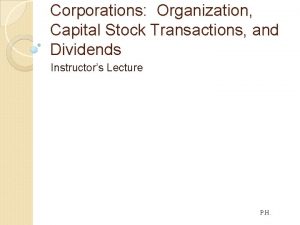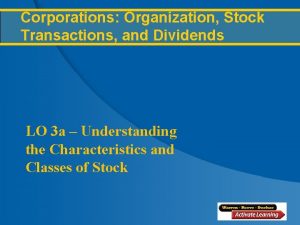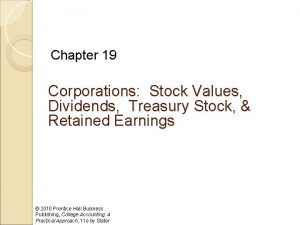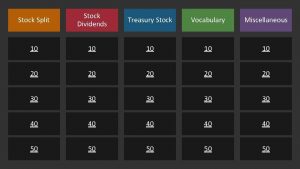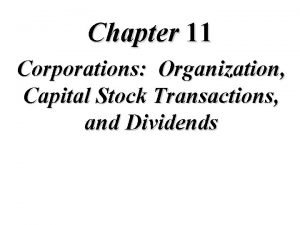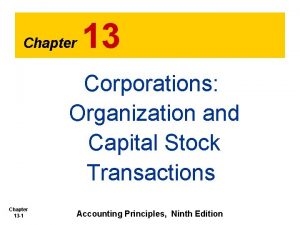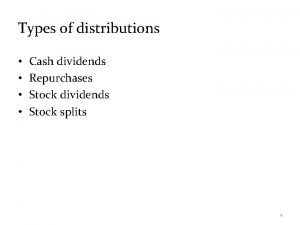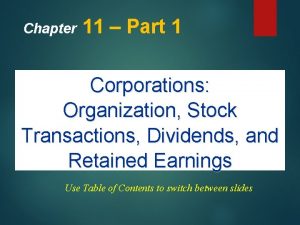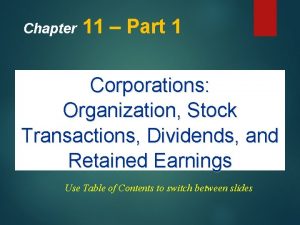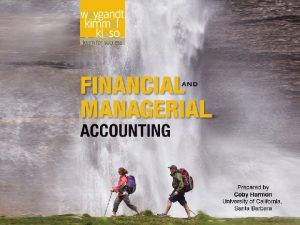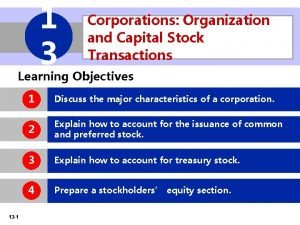Corporations Organization Stock Transactions and Dividends Chapter 13






















































- Slides: 54

Corporations: Organization, Stock Transactions, and Dividends Chapter 13 Student Version These slides should be viewed using the presentation mode (click the icon to start presentation). © 2011 Cengage Learning. All Rights Reserved. May not be copied, scanned, or duplicated, in whole or in part, except for use as permitted in a license distributed with a certain product or service or otherwise on a password-protected website for classroom use. Prepared by: C. Douglas Cloud Professor Emeritus of Accounting Pepperdine University

Learning Objective 1 1. Describe the nature of the corporate form of organization. © 2011 Cengage Learning. All Rights Reserved. May not be copied, scanned, or duplicated, in whole or in part, except for use as permitted in a license distributed with a certain product or service or otherwise on a password-protected website for classroom use.

LO 1 Characteristics of a Corporation è A corporation is a legal entity, distinct and separate from the individuals who create and operate it. As a legal entity, a corporation may acquire, own, and dispose of property in its own name. è A corporation sells shares of ownership, called stock. è The stockholders or shareholders who own the stock own the corporation. They can buy and sell stock without affecting the corporation’s operations or continued existence. © 2011 Cengage Learning. All Rights Reserved. May not be copied, scanned, or duplicated, in whole or in part, except for use as permitted in a license distributed with a certain product or service or otherwise on a password-protected website for classroom use.

LO 1 Characteristics of a Corporation èCorporations whose shares of stock are traded in public markets are called public corporations. è Corporations whose shares are not traded publicly are usually owned by a small group of investors and are called nonpublic or private corporations. The stockholders of all corporations have limited liability. © 2011 Cengage Learning. All Rights Reserved. May not be copied, scanned, or duplicated, in whole or in part, except for use as permitted in a license distributed with a certain product or service or otherwise on a password-protected website for classroom use.

LO 1 Characteristics of a Corporation èThe stockholders control a corporation by electing a board of directors. This board meets periodically to establish corporate policy. It also selects the chief executive officer (CEO) and other major officers. © 2011 Cengage Learning. All Rights Reserved. May not be copied, scanned, or duplicated, in whole or in part, except for use as permitted in a license distributed with a certain product or service or otherwise on a password-protected website for classroom use.

LO 1 Characteristics of a Corporation èA corporation has separate legal existence from its owners. èA corporation has transferable units of ownership. èA corporation has limited stockholders’ liability. èA corporation is subject to taxes. Thus, the corporate form has the disadvantage of double taxation. © 2011 Cengage Learning. All Rights Reserved. May not be copied, scanned, or duplicated, in whole or in part, except for use as permitted in a license distributed with a certain product or service or otherwise on a password-protected website for classroom use.

LO 1 Forming a Corporation èCosts may be incurred in organizing a corporation, such as legal fees, taxes, license fees, and promotional costs. The recording of a corporation’s organizing costs of $8, 500 on January 5 is shown below: © 2011 Cengage Learning. All Rights Reserved. May not be copied, scanned, or duplicated, in whole or in part, except for use as permitted in a license distributed with a certain product or service or otherwise on a password-protected website for classroom use.

Learning Objective 2 1. Describe the nature of the corporate form of organization. 2. Describe the two main sources of stockholders’ equity. © 2011 Cengage Learning. All Rights Reserved. May not be copied, scanned, or duplicated, in whole or in part, except for use as permitted in a license distributed with a certain product or service or otherwise on a password-protected website for classroom use.

LO 2 Stockholders’ Equity èThe owner’s equity in a corporation is called stockholders’ equity, shareholders’ investment, or capital. è Stockholders’ equity is reported by its two main sources. § Capital contributed to the corporation by the stockholders, called paid-in capital or contributed capital. § Net income retained in the business, called retained earnings. © 2011 Cengage Learning. All Rights Reserved. May not be copied, scanned, or duplicated, in whole or in part, except for use as permitted in a license distributed with a certain product or service or otherwise on a password-protected website for classroom use.

LO 2 Stockholders’ Equity èIf there is only one class of stock, the account is entitled Common Stock or Capital Stock. èRetained earnings is a corporation’s cumulative net income that has not been distributed as dividends. èDividends are distributions of a corporation’s earnings to stockholders. © 2011 Cengage Learning. All Rights Reserved. May not be copied, scanned, or duplicated, in whole or in part, except for use as permitted in a license distributed with a certain product or service or otherwise on a password-protected website for classroom use.

LO 2 Stockholders’ Equity è A debit balance in Retained Earnings is called a deficit. Such a balance often results from accumulated net losses. è A credit balance in Retained Earnings does not represent surplus cash or cash left over for dividends. © 2011 Cengage Learning. All Rights Reserved. May not be copied, scanned, or duplicated, in whole or in part, except for use as permitted in a license distributed with a certain product or service or otherwise on a password-protected website for classroom use.

Learning Objective 3 1. Describe the nature of the corporate form of organization. 2. Describe the two main sources of stockholders’ equity. 3. Describe and illustrate the characteristics of stock, classes of stock, and entries for issuing stock. © 2011 Cengage Learning. All Rights Reserved. May not be copied, scanned, or duplicated, in whole or in part, except for use as permitted in a license distributed with a certain product or service or otherwise on a password-protected website for classroom use.

LO 3 Characteristics of Stock èThe number of shares of stock that a corporation is authorized to issue is stated in the charter. èThe term issued refers to the shares issued to the stockholders. èA corporation may reacquire some of the stock that has been issued. The stock remaining in the hands of stockholders is then called outstanding stock. © 2011 Cengage Learning. All Rights Reserved. May not be copied, scanned, or duplicated, in whole or in part, except for use as permitted in a license distributed with a certain product or service or otherwise on a password-protected website for classroom use.

LO 3 Characteristics of Stock èCorporations may issue stock certificates to stockholders to document their ownership. èShares of stock are often assigned a dollar amount, called par value. èSome corporations have stopped issuing stock certificates except on special request. © 2011 Cengage Learning. All Rights Reserved. May not be copied, scanned, or duplicated, in whole or in part, except for use as permitted in a license distributed with a certain product or service or otherwise on a password-protected website for classroom use.

LO 3 Characteristics of Stock èStock issued without par is called no-par stock. Some states require the board of directors to assign a stated value to no-par stock. èSome state laws require that corporations maintain a minimum stockholder contribution, called legal capital, to protect creditors. © 2011 Cengage Learning. All Rights Reserved. May not be copied, scanned, or duplicated, in whole or in part, except for use as permitted in a license distributed with a certain product or service or otherwise on a password-protected website for classroom use.

LO 3 Characteristics of Stock èThe major rights that accompany ownership of a share of stock are as follows: § The right to vote in matters concerning the corporation. § The right to share in distributions of earnings. § The right to share in assets upon liquidation. © 2011 Cengage Learning. All Rights Reserved. May not be copied, scanned, or duplicated, in whole or in part, except for use as permitted in a license distributed with a certain product or service or otherwise on a password-protected website for classroom use.

LO 3 Classes of Stock èThe two primary classes of paid-in capital are common stock and preferred stock. èThe primary attractiveness of preferred stock is that it is given a preference to dividends over common stock. è The payment of dividends is authorized by the corporation’s board of directors. è When authorized, the directors are said to have declared a dividend. © 2011 Cengage Learning. All Rights Reserved. May not be copied, scanned, or duplicated, in whole or in part, except for use as permitted in a license distributed with a certain product or service or otherwise on a password-protected website for classroom use.

LO 3 Classes of Stock èCumulative preferred stock has a right to receive regular dividends that were not declared (paid) in prior years. § Noncumulative preferred stock does not have this right. § Cumulative preferred stock dividends that have not been paid in prior years are said to be in arrears. © 2011 Cengage Learning. All Rights Reserved. May not be copied, scanned, or duplicated, in whole or in part, except for use as permitted in a license distributed with a certain product or service or otherwise on a password-protected website for classroom use.

LO 3 Classes of Stock A corporation has issued the following preferred and common stock: 1, 000 shares of $4 cumulative preferred stock, $50 par 4, 000 shares of common stock, $15 par The corporation was organized on January 1, 2010, and paid no dividends in 2010 and 2011. In 2012, the corporation paid $22, 000 in dividends, of which $12, 000 was paid to preferred stockholders and $10, 000 was paid to common stockholders. (continued) © 2011 Cengage Learning. All Rights Reserved. May not be copied, scanned, or duplicated, in whole or in part, except for use as permitted in a license distributed with a certain product or service or otherwise on a password-protected website for classroom use.

LO 3 Classes of Stock Total dividends paid Preferred stockholders: 2010 dividends in arrears 2011 dividends in arrears 2012 dividends Total preferred dividends Dividends available to common stockholders $22, 000 $4, 000 © 2011 Cengage Learning. All Rights Reserved. May not be copied, scanned, or duplicated, in whole or in part, except for use as permitted in a license distributed with a certain product or service or otherwise on a password-protected website for classroom use. (12, 000) $10, 000

LO 3 Issuing Stock A corporation is authorized to issue 10, 000 shares of preferred stock, $100 par, and 100, 000 shares of common stock, $20 par. One-half of each class of authorized shares is issued at par for cash. © 2011 Cengage Learning. All Rights Reserved. May not be copied, scanned, or duplicated, in whole or in part, except for use as permitted in a license distributed with a certain product or service or otherwise on a password-protected website for classroom use.

LO 3 Issuing Stock èIf the stock is issued (sold) for a price that is more than its par, the stock has been sold at a premium. èIf the stock is issued (sold) for a price that is less than its par, the stock has been sold at a discount. © 2011 Cengage Learning. All Rights Reserved. May not be copied, scanned, or duplicated, in whole or in part, except for use as permitted in a license distributed with a certain product or service or otherwise on a password-protected website for classroom use.

LO 3 Premium on Stock Caldwell Company issues 2, 000 shares of $50 par preferred stock for cash at $55. © 2011 Cengage Learning. All Rights Reserved. May not be copied, scanned, or duplicated, in whole or in part, except for use as permitted in a license distributed with a certain product or service or otherwise on a password-protected website for classroom use.

LO 3 Premium on Stock A corporation acquired land for which the fair market value cannot be determined. In exchange for the land, the corporation issued 10, 000 shares of $10 par common that had a current market value of $12. © 2011 Cengage Learning. All Rights Reserved. May not be copied, scanned, or duplicated, in whole or in part, except for use as permitted in a license distributed with a certain product or service or otherwise on a password-protected website for classroom use.

LO 3 No-Par Stock On January 9, a corporation issues 10, 000 shares of no -par common stock at $40 a share. On June 27, the corporation issues an additional 1, 000 shares at $36. © 2011 Cengage Learning. All Rights Reserved. May not be copied, scanned, or duplicated, in whole or in part, except for use as permitted in a license distributed with a certain product or service or otherwise on a password-protected website for classroom use.

LO 3 No-Par Stock Using the same data as in the previous transaction, assume that the stock is assigned a stated value of $25. © 2011 Cengage Learning. All Rights Reserved. May not be copied, scanned, or duplicated, in whole or in part, except for use as permitted in a license distributed with a certain product or service or otherwise on a password-protected website for classroom use.

Learning Objective 4 1. Describe the nature of the corporate form of organization. 2. Describe the two main sources of stockholders’ equity. 3. Describe and illustrate the characteristics of stock, classes of stock, and entries for issuing stock. 4. Describe and illustrate the accounting for cash dividends and stock dividends. © 2011 Cengage Learning. All Rights Reserved. May not be copied, scanned, or duplicated, in whole or in part, except for use as permitted in a license distributed with a certain product or service or otherwise on a password-protected website for classroom use.

LO 4 Cash Dividends èA cash distribution of earnings by a corporation to its stockholders is called a cash dividend. The three conditions a corporation must meet to pay a cash dividend are as follows: § Sufficient retained earnings § Sufficient cash § Formal action by the board of directors © 2011 Cengage Learning. All Rights Reserved. May not be copied, scanned, or duplicated, in whole or in part, except for use as permitted in a license distributed with a certain product or service or otherwise on a password-protected website for classroom use.

LO 4 Cash Dividends èThe date of declaration is the date the board of directors formally authorized the payment of the dividend. On this date, the corporation incurs the liability to pay the amount of the dividend. èThe date of record is the date the corporation uses to determine which stockholders will receive the dividend. èThe date of payment is the date the corporation will pay the dividends to the stockholders who owned the stock on the date of record. © 2011 Cengage Learning. All Rights Reserved. May not be copied, scanned, or duplicated, in whole or in part, except for use as permitted in a license distributed with a certain product or service or otherwise on a password-protected website for classroom use.

LO 4 Cash Dividends On October 1, Hiber Corporation declares the cash dividends shown below with a date of record of November 10 and a date of payment of December 2. On October 1, the declaration date, Hiber Corporation records the following entry: © 2011 Cengage Learning. All Rights Reserved. May not be copied, scanned, or duplicated, in whole or in part, except for use as permitted in a license distributed with a certain product or service or otherwise on a password-protected website for classroom use.

LO 4 Cash Dividends On November 10, the date of record, no entry is required, since this date merely determines which stockholders will receive the dividends. On December 2, the date of payment, Hiber Corporation records the payment of the dividends as follows: © 2011 Cengage Learning. All Rights Reserved. May not be copied, scanned, or duplicated, in whole or in part, except for use as permitted in a license distributed with a certain product or service or otherwise on a password-protected website for classroom use.

LO 4 Stock Dividends èA distribution of dividends to stockholders in the form of the firm’s own shares is called a stock dividend. Stock dividends normally are declared only on common stock and issued to common stockholders. © 2011 Cengage Learning. All Rights Reserved. May not be copied, scanned, or duplicated, in whole or in part, except for use as permitted in a license distributed with a certain product or service or otherwise on a password-protected website for classroom use.

LO 4 Stock Dividends On December 15, the board of directors of Hendrix Corporation declares a 5 percent stock dividend of 100, 000 shares (2, 000 shares × 5%) to be issued on January 10 to stockholders of record on December 31. The market price on the declaration date is $31 per share. © 2011 Cengage Learning. All Rights Reserved. May not be copied, scanned, or duplicated, in whole or in part, except for use as permitted in a license distributed with a certain product or service or otherwise on a password-protected website for classroom use.

LO 4 Stock Dividends The entry to record the declaration of the 5 percent stock dividend is as follows: © 2011 Cengage Learning. All Rights Reserved. May not be copied, scanned, or duplicated, in whole or in part, except for use as permitted in a license distributed with a certain product or service or otherwise on a password-protected website for classroom use.

LO 4 Stock Dividends At the end of the period, the stock dividends distributable and paid-in capital in excess of par— common stock accounts are reported in the Paid-In Capital section of the balance sheet. Thus, the effect of the preceding stock dividend is to transfer $3, 100, 000 of retained earnings to paid-in capital. © 2011 Cengage Learning. All Rights Reserved. May not be copied, scanned, or duplicated, in whole or in part, except for use as permitted in a license distributed with a certain product or service or otherwise on a password-protected website for classroom use.

LO 4 Stock Dividends On January 10, the stock dividend is distributed to stockholders by issuing 100, 000 shares of common stock. The following entry records the issue of the stock: © 2011 Cengage Learning. All Rights Reserved. May not be copied, scanned, or duplicated, in whole or in part, except for use as permitted in a license distributed with a certain product or service or otherwise on a password-protected website for classroom use.

Learning Objective 5 1. Describe the nature of the corporate form of organization. 2. Describe the two main sources of stockholders’ equity. 3. Describe and illustrate the characteristics of stock, classes of stock, and entries for issuing stock. 4. Describe and illustrate the accounting for cash dividends and stock dividends. 5. Describe and illustrate the accounting for treasury stock transactions. © 2011 Cengage Learning. All Rights Reserved. May not be copied, scanned, or duplicated, in whole or in part, except for use as permitted in a license distributed with a certain product or service or otherwise on a password-protected website for classroom use.

LO 5 Treasury Stock Transactions èTreasury stock is stock that a corporation has issued and then reacquired. A corporation may purchase its own stock for a variety of reasons, including the following: § To provide shares for resale to employees § To reissue as bonuses to employees, or § To support the market price of the stock © 2011 Cengage Learning. All Rights Reserved. May not be copied, scanned, or duplicated, in whole or in part, except for use as permitted in a license distributed with a certain product or service or otherwise on a password-protected website for classroom use.

LO 5 Treasury Stock Transactions On February 13, a firm purchased 1, 000 shares of treasury stock (common stock, $25 par) at $45 per share. The cost method for accounting for treasury stock is used. The entry to record the purchase of the treasury stock is as follows: © 2011 Cengage Learning. All Rights Reserved. May not be copied, scanned, or duplicated, in whole or in part, except for use as permitted in a license distributed with a certain product or service or otherwise on a password-protected website for classroom use.

LO 5 Treasury Stock Transactions On April 29, the corporation sells 600 shares of the treasury stock for $60. The entry to record the sale is as follows: The amount (per share) debited to Treasury Stock when purchased is the amount per share that must be credited to that account when sold (600 x $45). © 2011 Cengage Learning. All Rights Reserved. May not be copied, scanned, or duplicated, in whole or in part, except for use as permitted in a license distributed with a certain product or service or otherwise on a password-protected website for classroom use.

LO 5 Treasury Stock Transactions On October 4, the corporation sells the remaining 400 shares of treasury stock for $40 per share. The entry to record the sale is as follows: © 2011 Cengage Learning. All Rights Reserved. May not be copied, scanned, or duplicated, in whole or in part, except for use as permitted in a license distributed with a certain product or service or otherwise on a password-protected website for classroom use.

Learning Objective 6 6. Describe and illustrate the reporting of stockholders’ equity. © 2011 Cengage Learning. All Rights Reserved. May not be copied, scanned, or duplicated, in whole or in part, except for use as permitted in a license distributed with a certain product or service or otherwise on a password-protected website for classroom use.

LO 6 Reporting Retained Earnings èChanges to retained earnings may be reported using one of the following: § Separate retained earnings statement § Combined income and retained earnings statement § Statement of stockholders’ equity © 2011 Cengage Learning. All Rights Reserved. May not be copied, scanned, or duplicated, in whole or in part, except for use as permitted in a license distributed with a certain product or service or otherwise on a password-protected website for classroom use.

LO 6 Restrictions èThe retained earnings available for use as dividends may be restricted by action of a corporation’s board of directors. èThese amounts, called restrictions or appropriations, remain part of the retained earnings. However, they must be disclosed, usually in the notes to the financial statements. © 2011 Cengage Learning. All Rights Reserved. May not be copied, scanned, or duplicated, in whole or in part, except for use as permitted in a license distributed with a certain product or service or otherwise on a password-protected website for classroom use.

LO 6 Restrictions èRestrictions of retained earnings are classified as follows: § Legal. State laws may require a restriction of retained earnings. § Contractual. A corporation may enter into contracts that require restrictions of retained earnings. § Discretionary. A corporation’s board of directors may restrict retained earnings voluntarily. © 2011 Cengage Learning. All Rights Reserved. May not be copied, scanned, or duplicated, in whole or in part, except for use as permitted in a license distributed with a certain product or service or otherwise on a password-protected website for classroom use.

LO 6 Prior Period Adjustments èErrors may not be discovered within the same period in which they occur. The correction of this type of error, called a prior period adjustment, is reported in the retained earnings statement as an adjustment to the beginning balance of retained earnings. © 2011 Cengage Learning. All Rights Reserved. May not be copied, scanned, or duplicated, in whole or in part, except for use as permitted in a license distributed with a certain product or service or otherwise on a password-protected website for classroom use.

LO 6 Statement of Stockholders’ Equity èWhen the only change to stockholders’ equity is due to net income or net loss and dividends, a retained earnings statement is sufficient. èWhen a corporation also has changes in stock and paid-in capital accounts, a statement of stockholders’ equity is normally prepared. © 2011 Cengage Learning. All Rights Reserved. May not be copied, scanned, or duplicated, in whole or in part, except for use as permitted in a license distributed with a certain product or service or otherwise on a password-protected website for classroom use.

Learning Objective 7 6. Describe and illustrate the reporting of stockholders’ equity. 7. Describe the effect of stock splits on corporate financial statements. © 2011 Cengage Learning. All Rights Reserved. May not be copied, scanned, or duplicated, in whole or in part, except for use as permitted in a license distributed with a certain product or service or otherwise on a password-protected website for classroom use.

LO 7 Stock Splits èA stock split is a process by which a corporation reduces the par or stated value of its common stock and issues a proportionate number of additional shares. © 2011 Cengage Learning. All Rights Reserved. May not be copied, scanned, or duplicated, in whole or in part, except for use as permitted in a license distributed with a certain product or service or otherwise on a password-protected website for classroom use.

LO 7 Stock Splits Rojek Corporation has 10, 000 shares of $100 par common stock outstanding with a current market price of $150 per share. The board of directors declares the following stock split: 1. Each common shareholder will receive 5 shares for each share held. 2. The par of each share of common stock will be reduced to $20 ($100/5). © 2011 Cengage Learning. All Rights Reserved. May not be copied, scanned, or duplicated, in whole or in part, except for use as permitted in a license distributed with a certain product or service or otherwise on a password-protected website for classroom use.

Learning Objective 8 6. Describe and illustrate the reporting of stockholders’ equity. 7. Describe the effect of stock splits on corporate financial statements. 8. Describe and illustrate the use of earnings per share in evaluating a company’s profitability. © 2011 Cengage Learning. All Rights Reserved. May not be copied, scanned, or duplicated, in whole or in part, except for use as permitted in a license distributed with a certain product or service or otherwise on a password-protected website for classroom use.

LO 8 Earnings per Share èEarnings per common share (EPS), sometimes called basic earnings per share, is the net income per share of common stock outstanding during a period. èEarnings per share is computed as follows: Net Income – Preferred Dividends Earnings per Share = Average Number of Common Shares Outstanding © 2011 Cengage Learning. All Rights Reserved. May not be copied, scanned, or duplicated, in whole or in part, except for use as permitted in a license distributed with a certain product or service or otherwise on a password-protected website for classroom use.

LO 8 Earnings per Share © 2011 Cengage Learning. All Rights Reserved. May not be copied, scanned, or duplicated, in whole or in part, except for use as permitted in a license distributed with a certain product or service or otherwise on a password-protected website for classroom use.

Corporations: Organization, Stock Transactions, and Dividends The End Student Version Prepared by: C. Douglas Cloud Professor Emeritus of Accounting Pepperdine University © 2011 Cengage Learning. All Rights Reserved. May not be copied, scanned, or duplicated, in whole or in part, except for use as permitted in a license distributed with a certain product or service or otherwise on a password-protected website for classroom use.
 Journal entry stock dividend
Journal entry stock dividend Chapter 7 corporations act
Chapter 7 corporations act Corporate capital
Corporate capital Characteristics of corporation
Characteristics of corporation Learnnowbiz
Learnnowbiz Accounting for corporations chapter 13
Accounting for corporations chapter 13 Capital stock transactions
Capital stock transactions Net profit after tax and preference dividends
Net profit after tax and preference dividends Corporations mergers and multinationals
Corporations mergers and multinationals Long-term debt preferred stock and common stock
Long-term debt preferred stock and common stock Characteristics of common stock
Characteristics of common stock Specified private activity bond interest dividends
Specified private activity bond interest dividends Dividends of workplace diversity
Dividends of workplace diversity Dividend policy example
Dividend policy example Acct 100
Acct 100 Dmsbr
Dmsbr Closing entries dividends
Closing entries dividends Homemade dividends
Homemade dividends Mc stock dividend
Mc stock dividend Multinational vs transnational
Multinational vs transnational Multinational vs international
Multinational vs international Disadvantages of corporations
Disadvantages of corporations Mnc company definition
Mnc company definition Strategic management a dynamic perspective
Strategic management a dynamic perspective Types of corporations
Types of corporations Crabtree-vickers v australian direct mail
Crabtree-vickers v australian direct mail Karakteristik perusahaan multinasional
Karakteristik perusahaan multinasional Domestic structure plus foreign subsidiary
Domestic structure plus foreign subsidiary Objectives of multinational corporations
Objectives of multinational corporations Corporations developed rapidly in the 1830s
Corporations developed rapidly in the 1830s Characteristics of corporations
Characteristics of corporations Cairan dari hasil rebusan daging disebut
Cairan dari hasil rebusan daging disebut Stock initial - stock final
Stock initial - stock final Point to point organization
Point to point organization Problem 5-8 completing the accounting equation
Problem 5-8 completing the accounting equation Process organization in computer organization
Process organization in computer organization Analyzing transactions
Analyzing transactions Chapter 5 transactions that affect
Chapter 5 transactions that affect Assets increase on the debit side
Assets increase on the debit side A form for recording transactions in chronological order
A form for recording transactions in chronological order Journalizing transactions
Journalizing transactions Part two analyzing transactions into debit and credit parts
Part two analyzing transactions into debit and credit parts Accounting business transactions
Accounting business transactions Capital=assets+liabilities
Capital=assets+liabilities Problem 7-1 opening ledger accounts
Problem 7-1 opening ledger accounts Aerospace and electronic systems society
Aerospace and electronic systems society Grits immunization login
Grits immunization login Transactions and concurrency control in distributed systems
Transactions and concurrency control in distributed systems Transactions that affect revenue expenses and withdrawals
Transactions that affect revenue expenses and withdrawals Analyzing and recording transactions
Analyzing and recording transactions Part six recording bank and petty cash transactions answers
Part six recording bank and petty cash transactions answers Analyzing and recording transactions
Analyzing and recording transactions A lock that allows concurrent transactions
A lock that allows concurrent transactions Walt downing
Walt downing Aerospace and electronic systems
Aerospace and electronic systems
